Welcome to our blog for the Plastic in the Pacific Crusade. If you missed the earlier editions please go to category file in the footer to go back and read them. They are listed under Plastic in the Pacific. Over the coming year we will be writing regularly of our adventures and what we are seeing. In this article we sail to Raiatea and Tahaa, French Polynesia
Raiatea is known as the sailing capital of French Polynesia. Tahaa is the island just north of it and is enclosed within the same reef. With a length of 23nm north to south and 9nm east to west at its widest, there are plenty of areas to explore within these two islands themselves, let alone the fact Huahine and Bora Bora are just a short sail east or west.
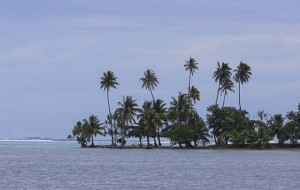 We set sail from Huahine once the wind had abated a little. We were forecast to have northerlies so the 20nm run across should be quick and easy, however nothing is that simple in sailing. With more weather around, we of course had rain and that meant shifty winds and as we got half way across, the wind turned hard on the nose which meant changing our course to another entrance. Lucky there are 11 options between these two islands. Instead of heading through Teavapiti pass we ended up further south at Iriru Ou Maire Pass. No big issue as we would cruise back up to Teavaptit pass inside the reef.
We set sail from Huahine once the wind had abated a little. We were forecast to have northerlies so the 20nm run across should be quick and easy, however nothing is that simple in sailing. With more weather around, we of course had rain and that meant shifty winds and as we got half way across, the wind turned hard on the nose which meant changing our course to another entrance. Lucky there are 11 options between these two islands. Instead of heading through Teavapiti pass we ended up further south at Iriru Ou Maire Pass. No big issue as we would cruise back up to Teavaptit pass inside the reef.
We wanted to get to Teavapiti Pass as the pass dive here is the best in this chain, especially famous for the shark pre-school that hangs out on the 10m contour. However as we approached, and with all the rain, once again, visibility was shocking with run off. We still anchored on the south west point of Ofetaro Island and would have a look later in the day. One thing with pass diving is you want to have an incoming tide and the tide was due to change at 1645. We set up and took our two lady guests to the island whilst we went diving. We went out the passage to find the tide had not changed so we opted to dive the inside wall. Whilst visibility was poor, there were hundreds of trigger fish and the coral was actually quite good, well for hard coral gardens, still finding it hard to compare to the Great Barrier Reef which is still the best in the world in our opinion.
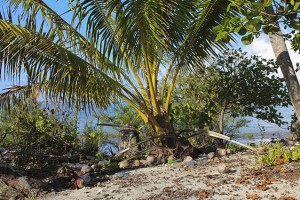 Once we finished our dive we picked up the ladies and they had renamed the island ‘Cat Island’ with over 10 stray cats running around. Scattered amongst the cats were once again lots of rubbish, mainly plastic bottles. This is a perfect little island that people dream of visiting, no buildings, just palm trees and beaches, surrounded in reasonably good reef. Yet so much debris. Later in our trip we did actually see some locals cleaning it up so maybe there was a function for the island coming up or something, but no one should need to clean up other people’s mess. I thought we all learnt as children to clean up after ourselves.
Once we finished our dive we picked up the ladies and they had renamed the island ‘Cat Island’ with over 10 stray cats running around. Scattered amongst the cats were once again lots of rubbish, mainly plastic bottles. This is a perfect little island that people dream of visiting, no buildings, just palm trees and beaches, surrounded in reasonably good reef. Yet so much debris. Later in our trip we did actually see some locals cleaning it up so maybe there was a function for the island coming up or something, but no one should need to clean up other people’s mess. I thought we all learnt as children to clean up after ourselves.
After our dive we went and anchored out the front of Uturoa Marina. It is a bit rocky but good holding. You can go to the public wharf in Uturoa but unfortunately with the turn down in tourism, there seem to be some desperate people and it is quite common for vessels to be boarded at night and things stolen, so we weren’t going to risk that. It would be O.K to pull up during the day but leave before dark. The following morning we went for a walk into Uturoa and did some shopping. There is a large supermarket that seems to be the most expensive in the island chain, and local market just down the street for fresh goods and souvenirs. For some reason there seems to be a lot of electronic goods shops.
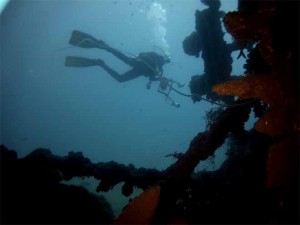 Back on the boat and we wanted to dive a wreck called the Norby which is a 53m triple masted sailing vessel that sunk in 1900. I’ve never been on a wreck that old before so we were looking forward to it. It is located in the north of Tepua Bay located off the, now closed, resort. There is a mooring and a white bottle. We picked up the mooring and not knowing if this was like Tahiti and the wreck was at the bottom of the mooring or if it was on the white bottle, we descended down on the boat mooring. At the bottom we came across sand so we headed to towards the milk bottle. It was still not good visibility and as we cruised along the bottom it was barren, just sand. And then out of the murkiness appears some darker patches and then a shadow appeared above us. The wreck is on her Port side with the bow pointing towards the west. It obviously had a steel hull covered in a pretty good paint as the hull still seems in one piece. The deck however was timber and it has the steel frame left, meaning penetration of the wreck is easy as the timber has mostly rotted away. The only growth on the wreck after 116 years seems to be giant clams, however there were quite a few fish and a giant moray eel slid out of the bow near the anchor chain that was deployed, so it was obvious this wreck sank whilst anchored.
Back on the boat and we wanted to dive a wreck called the Norby which is a 53m triple masted sailing vessel that sunk in 1900. I’ve never been on a wreck that old before so we were looking forward to it. It is located in the north of Tepua Bay located off the, now closed, resort. There is a mooring and a white bottle. We picked up the mooring and not knowing if this was like Tahiti and the wreck was at the bottom of the mooring or if it was on the white bottle, we descended down on the boat mooring. At the bottom we came across sand so we headed to towards the milk bottle. It was still not good visibility and as we cruised along the bottom it was barren, just sand. And then out of the murkiness appears some darker patches and then a shadow appeared above us. The wreck is on her Port side with the bow pointing towards the west. It obviously had a steel hull covered in a pretty good paint as the hull still seems in one piece. The deck however was timber and it has the steel frame left, meaning penetration of the wreck is easy as the timber has mostly rotted away. The only growth on the wreck after 116 years seems to be giant clams, however there were quite a few fish and a giant moray eel slid out of the bow near the anchor chain that was deployed, so it was obvious this wreck sank whilst anchored.
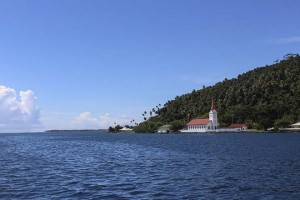 After diving this we headed off to Tau Tau Island, regarded as one of the nicest islands to visit. It was on the west coast of Tahaa and cruising the flats between the islands, over azure waters with reefs scattered everywhere was beautiful. A couple of little islands had small huts on them and a relatively new one even had a juvenile palm tree growing. It was going to be that perfect little island one day, as long as the trash stays off it. On the west coast of Tahaa we passed one of the most gorgeous churches we’ve seen so far. Located right at the waters edge, it even had the ability to berth boats, what a way to get to church. Arriving at Tau Tau we anchored in 6m of water and the water color was ridiculous. Perfect blue waters and you could see the difference between the reef and sand easily so anchor placement was not an issue. The island has a large resort on it with those typical bures over the water. At least these ones had a sandy bottom instead of brown waters like Tahiti.
After diving this we headed off to Tau Tau Island, regarded as one of the nicest islands to visit. It was on the west coast of Tahaa and cruising the flats between the islands, over azure waters with reefs scattered everywhere was beautiful. A couple of little islands had small huts on them and a relatively new one even had a juvenile palm tree growing. It was going to be that perfect little island one day, as long as the trash stays off it. On the west coast of Tahaa we passed one of the most gorgeous churches we’ve seen so far. Located right at the waters edge, it even had the ability to berth boats, what a way to get to church. Arriving at Tau Tau we anchored in 6m of water and the water color was ridiculous. Perfect blue waters and you could see the difference between the reef and sand easily so anchor placement was not an issue. The island has a large resort on it with those typical bures over the water. At least these ones had a sandy bottom instead of brown waters like Tahiti.
Annika finished off a dive course with one of our guests and the two ladies got dropped off on the island north of Tau Tau so they could go snorkeling. Cruising in over the shallows we saw a black tip reef shark cruising along. Arriving at a palm covered island, I could see immediately that this island followed the same trend as every other island around here. It was good from far, but far from good. Plastic bottles and other rubbish littered what should have been the perfect little island. Crawling amongst it were lots of crabs, running to their holes as you got anywhere near them.
 After diving the rest of us joined the ladies. The place between the two islands is called the aquarium. You walk as far to the west as you can before you get to the reef edge. The water runs through between the islands, always east bound. I couldn’t work out the timing but on an incoming tide the water runs too quick and everything gets stirred up, however on this occasion the water was running at a good pace and launching into the water for a snorkel, you are faced with waters about 50cm deep at best. There is ample corals and hundreds, if not thousands of fish. You simply drift along in the current, however sometimes you want to stop and you have to grab whatever you can. You try to find a rock that doesn’t have corals on it. As you sit there waving like a flag in the water, the fish come to you. The locals feed them so they expect to be fed so you end up with lots of angels, butterfly, wrasse and damsels all around you. The butterfly fish sit under your belly and the damsels try and attack your hands to defend their home.
After diving the rest of us joined the ladies. The place between the two islands is called the aquarium. You walk as far to the west as you can before you get to the reef edge. The water runs through between the islands, always east bound. I couldn’t work out the timing but on an incoming tide the water runs too quick and everything gets stirred up, however on this occasion the water was running at a good pace and launching into the water for a snorkel, you are faced with waters about 50cm deep at best. There is ample corals and hundreds, if not thousands of fish. You simply drift along in the current, however sometimes you want to stop and you have to grab whatever you can. You try to find a rock that doesn’t have corals on it. As you sit there waving like a flag in the water, the fish come to you. The locals feed them so they expect to be fed so you end up with lots of angels, butterfly, wrasse and damsels all around you. The butterfly fish sit under your belly and the damsels try and attack your hands to defend their home.
It is truly a spectacular little piece of water and even though it is frequented by lots of people who would obviously tread on it, grab hold of it and rub against it, it still seems quite pristine. Maybe that’s because we were seeing it after quiet season but it was one of the best snorkels I’ve had. At the end, whilst Annika was getting the tender and telling me to join them, I found a perfect anemone with two nemo’s. With the color of the water, it made for the perfect photo and the next day I would return with the GoPro mounted to a weight and would create what I will later work into ‘Fish TV.’ I literally left the camera in one spot for 30 minutes and the damsels and nemo came and went and the anemone just drifts around in the waters, it came out pretty good.
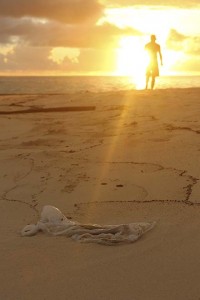 That night we all jumped in the dinghy and went to the south west point of the island for sunset. We landed just before sunset which was really lucky. We got about 10 minutes on the island before security got there. Apparently it is a private island. However we got the perfect sunset shot with the palm trees in the shot. There is even a perfect shot of me that Annika took. It is me in the sunset and there is a beam of light coming over my shoulder and pointing straight at a plastic bag washed up on the beach. Annika has named the photo ‘Plastic Bag Man’ a nick name I got when I sailed around Australia in 2010. The security guy got angry as I tried to explain to him that there is no information to say that it is private, and that the sign on the trees look like it means you can’t go past a certain point, so as he got angrier and angrier, I told him to pick up his trash and pointed out the bag. He didn’t care and left the bag on the beach. Not a good attitude to have my friend. We of course went back and picked it up.
That night we all jumped in the dinghy and went to the south west point of the island for sunset. We landed just before sunset which was really lucky. We got about 10 minutes on the island before security got there. Apparently it is a private island. However we got the perfect sunset shot with the palm trees in the shot. There is even a perfect shot of me that Annika took. It is me in the sunset and there is a beam of light coming over my shoulder and pointing straight at a plastic bag washed up on the beach. Annika has named the photo ‘Plastic Bag Man’ a nick name I got when I sailed around Australia in 2010. The security guy got angry as I tried to explain to him that there is no information to say that it is private, and that the sign on the trees look like it means you can’t go past a certain point, so as he got angrier and angrier, I told him to pick up his trash and pointed out the bag. He didn’t care and left the bag on the beach. Not a good attitude to have my friend. We of course went back and picked it up.
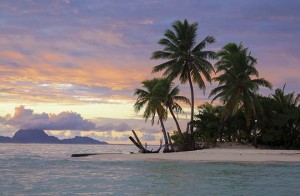 The next day we took off early to PaiPai Pass, about 3nm south of Tau Tau. We wanted to dive the pass. We had been told by locals that the tides in the book are all wrong and that there is a solar tide, tide comes in during the morning and out during the afternoon. Well the entire time we were in the Society Islands, we never found an in-coming tide in any pass. The water was always going out. So we had to dive the inner parts of the pass with the tender in tow. We dived the south side first and it was pretty unimpressive. O.K there were some nice corals but the best part was the shells that had been left behind by the locals. These pearl like shells are huge and when I clean one up they will be very impressive. Just need the right tools. They come up a dark green on the outside and a pearl on the inside. They are about 15cm wide. The north side was not much better, but a bad dive is still better than a good day at work and Annika found a fish she’s never seen before, a leafy scorpion fish. Hard to see as they are very well camouflaged.
The next day we took off early to PaiPai Pass, about 3nm south of Tau Tau. We wanted to dive the pass. We had been told by locals that the tides in the book are all wrong and that there is a solar tide, tide comes in during the morning and out during the afternoon. Well the entire time we were in the Society Islands, we never found an in-coming tide in any pass. The water was always going out. So we had to dive the inner parts of the pass with the tender in tow. We dived the south side first and it was pretty unimpressive. O.K there were some nice corals but the best part was the shells that had been left behind by the locals. These pearl like shells are huge and when I clean one up they will be very impressive. Just need the right tools. They come up a dark green on the outside and a pearl on the inside. They are about 15cm wide. The north side was not much better, but a bad dive is still better than a good day at work and Annika found a fish she’s never seen before, a leafy scorpion fish. Hard to see as they are very well camouflaged.
In the afternoon we went back to Tau Tau as we wanted to snorkel again. This time sunset was on the boat. The next day would be the last day on the boat for our guests. So we would take off early across to Bora Bora. We didn’t explore much of this area but what we did see was good and bad. The rubbish issue prevailed once again. Perfect islands strewn with palm trees but for every palm tree there were 2 plastic bottles. It is a real shame and any wonder tourism has been in a downward spiral. How can the government not understand? In this instance, plastic is not just an environmental threat, it is a threat to the very existence of the people on the islands. Without tourism, the main township of Uturoa is already seeing crime, something that simply should not happen in such a paradise. I’m not saying plastic is the only cause, but it’s certainly not helping. Who wants to go to paradise and see rubbish?
In our next edition we head across to Bora Bora, what was once regarded as the most beautiful island in the Pacific, if not the world. Why is it not regarded as that now, well we would find out pretty quickly.
Ocean Crusaders are out to change the way people treat our oceans. Our online education program is free to download at www.OceanCrusaders.org/education where children can learn of the issues our oceans are facing and how they can make a difference. The Plastic in the Pacific Crusade is about educating the South Pacific Islands, finding out what is happening in these islands and updating our programs.
Ocean Crusaders Plastic in the Pacific Crusade is proudly supported by: Cressi Dive Gear, Gill Marine, Keen Footwear Australia, Barz Optics Sunglasses, Maxsea Navigation Software, Digital Diver Cairns, LED Dive Lights Australia, Boat Names Australia, Predictwind Weather & Sail-world.com
[cincopa AgBAJb9CRKFe]
SIGN UP FOR OUR BLOGS